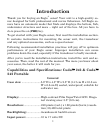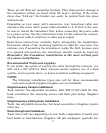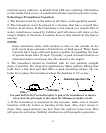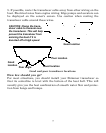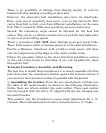9
There is no possibility of damage from floating objects. It can't be
knocked off when docking or loading on the trailer.
However, the shoot-thru-hull installation does have its drawbacks.
First, some loss of sensitivity does occur, even on the best hulls. This
varies from hull to hull, even from different installations on the same
hull. This is caused by differences in hull lay-up and construction.
Second, the transducer angle cannot be adjusted for the best fish
arches. This can be a problem on hulls that sit with the bow high when
at rest or at slow trolling speeds.
Third, a transducer CAN NOT shoot through wood and metal hulls.
Those hulls require either a transom mount or a thru-hull installation.
Fourth, a Skimmer transducer with a built-in temp sensor will show
only the temperature of the bilge, not the water surface temp.
Follow the procedure listed in the shoot-thru-hull installation section
at the end of this lesson to determine if you can satisfactorily shoot
through the hull.
Transom Transducer Assembly and Mounting
The best way to install these transducers is to loosely assemble all of the
parts first, place the transducer's bracket against the transom and see if
you can move the transducer so that it's parallel with the ground.
1. Assembling the bracket. Press the two small plastic ratchets into
the sides of the metal bracket as shown in the following illustration.
Notice there are letters molded into each ratchet. Place each ratchet
into the bracket with the letter "A" aligned with the dot stamped into
the metal bracket.
This position sets the transducer's coarse angle adjustment for a 14°
transom. Most outboard and stern-drive transoms have a 14° angle.



